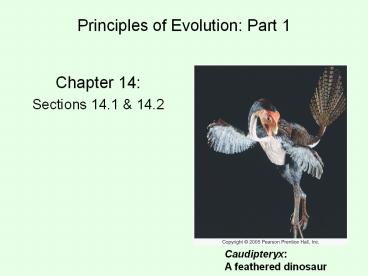Principles of Evolution: Part 1 - PowerPoint PPT Presentation
Title:
Principles of Evolution: Part 1
Description:
Principles of Evolution: Part 1 Chapter 14: Sections 14.1 & 14.2 Caudipteryx: A feathered dinosaur – PowerPoint PPT presentation
Number of Views:202
Avg rating:3.0/5.0
Title: Principles of Evolution: Part 1
1
Principles of Evolution Part 1
Chapter 14 Sections 14.1 14.2
- Caudipteryx
- A feathered dinosaur
2
Evolution vs Creationism
- In(1950), my pre-decessor Pope Pius XII has
already affirmed that there is no conflict
between evolution and the doctrine of the faith
regarding man and his vocation, confirming that
not only, to him and the people of his faith, are
God and Evolution not mutually exclusive, but
capable of coexistence - John Paul II
3
Evolution Defined
- Evolution is the change in the genetic
composition, and thus the characteristics, of a
population over generations.
4
How did evolutionary thought evolve?
- Early scientists (i.e. Plato, Aristotle)
- Life forms are fixed unchanging from their
moment of creation by God. - 18th century naturalists observe and catalog the
diversity of life - Notice high levels of diversity
- Notice resemblance of species to each other
- Asked Do similar species have a common ancestor?
5
How did evolutionary thought evolve?
- Discoveries of fossils
- A fossil is any part or trace of an organism
preserved in rock or sediment
Fig. 14-3
6
Other fossil types
Living fossils
Amber
Body parts
7
How did evolutionary thought evolve?
- Organization of fossil layers (Smith)
- Particular fossils always found in the same rock
layers. - The organization of fossils and layers was
consistent. - Organisms in upper layers (younger rocks) more
closely resembled modern organisms.
Fig. 14-4
8
How did evolutionary thought evolve?
- Non-evolutionary explanations for fossils
- Cuvier catastrophism
- Many species initially created, but successive
catastrophes destroyed most species - Prediction Fossils of modern species should be
found in all layers. - Not supported by data!
- Louis Agassizs modification of catastrophism
- New creations occurred after each catastrophe.
- Periods of catastrophic extinctions seen in
fossil layers.
9
How did evolutionary thought evolve?
- LeClerc combined non-evolutionary and
evolutionary mechanisms - Original creation ? a few species
- Modern species were conceived by Nature and
produced in Time by natural processes. - Similar to theistic evolution thought.
10
How did evolutionary thought evolve?
- Age of the earth and time for evolution
- Hutton and Lyell Uniformitarianism
- Layering of rocks occurred consistently over time
- Caused by natural processes (wind, water,
earthquakes volcanoes) - Their calculations suggested earth was at least
millions of years old
11
How did evolutionary thought evolve?
- Lamarcks hypothesis Evolution of acquired
characteristics - Concept
- Animals change through lifetime
- Changes acquired are passed to offspring
- Example
- Ancestral giraffes stretched their necks to reach
for high vegetation. - The trait of a longer neck was passed to
offspring. - NOTE Falsified based on principles of
inheritance via genes. (MENDEL)
12
How did evolutionary thought evolve?
- Darwin and Wallace developed current theory of
evolution by natural selection - Based their theory on observations made in their
travels - Darwins voyage of the Beagle Wallaces travels
in Indonesia! - Key observation Many species differ only in
subtle, yet ecologically important ways - Example Darwins finches
13
Darwins finches (Galapagos)
- Beak size and shape were related to food type
- Other aspects were similar, suggesting the birds
were related
Fig. 14-5
14
Theory of Evolution by Natural Selection
- Evolution and Natural selection are not the
same thing! - Evolution is...change in the genetic make-up of a
population over generations. - Darwin and Wallaces theory of evolution by
natural selection is an explanation for one
mechanism of evolution. - Natural selection is not the only mechanism of
evolution. - We will discuss other mechanisms in a later
lecture.
15
Theory of Evolution by Natural Selection
- Natural selection defined
- The differential survival and reproduction of
members of a population that occurs on the basis
of differences among individuals in their
adaptation to the environment. - Environment includes all aspects of their
niche, both living and non-living. - The theory is based on four observations along
with the conclusions derived from these
observations. - We will go through these step by step
16
Theory of Evolution by Natural Selection
Be sure you understand what is meant by each of
the observations and conclusions. Dont just
memorize them!
17
Theory of Evolution by Natural Selection
- Many animals have large numbers of offspring
- Only some of these survive to adulthood
- Only some of the adults will reproduce
Many Dolomedes spider juveniles.
18
Theory of Evolution by Natural Selection
- Variations in size, color, spotting/striped
patterns, disease resistance, etc. affect
survivorship and reproduction. - What survives is determined by the environment.
- Natural selection
19
- Fig. 1-21
- Natural selection at work.
20
- Natural selection at work
- Which survive depends on the environment

